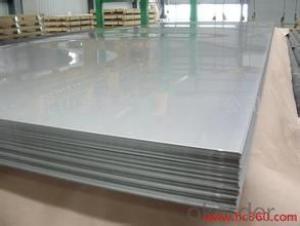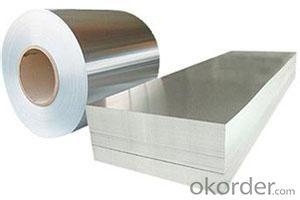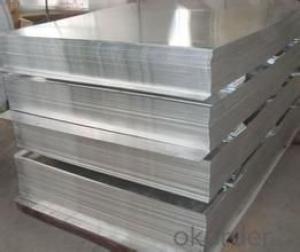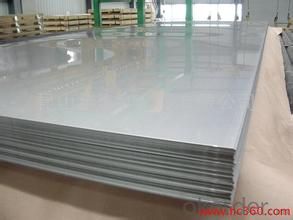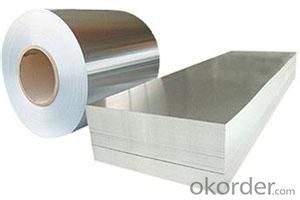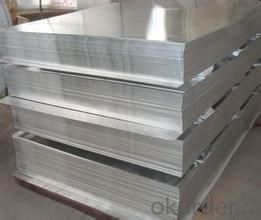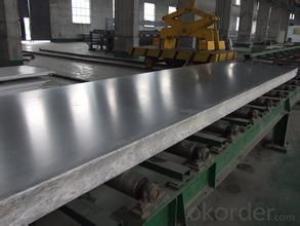Large Anodized Mill Finish Aluminum Sheet, Strip, Plate Hot Wholesale in China
- Loading Port:
- China main port
- Payment Terms:
- TT or LC
- Min Order Qty:
- 1000 m.t.
- Supply Capability:
- 1000 m.t./month
OKorder Service Pledge
OKorder Financial Service
You Might Also Like
Aluminium is a relatively soft,durable, lightweight, ductile and malleablemetal with appearance ranging from silvery to dull gray,depending on the surface roughness. It is nonmagnetic and does not easilyignite. A fresh film of aluminium serves as a good reflector (approximately92%) of visible light and an excellent reflector (as much as98%) of medium and far infrared radiation. The yield strength of pure aluminium is 7–11 MPa,while aluminium alloys have yield strengths ranging from200 MPa to 600 MPa. Aluminium has about one-third the density and stiffnessof steel. It iseasily machined,cast, drawn and extruded.
Alu Plate
Alloy: AA1050, 1060, 1100, AA3003, 3005, 3015, 5052, 5754, 5083,8011,etc
Temper:H14/16/18/22/24/32,HO etc.
Thickness:0.2mm—100mm
Width:100mm—2300mm (Can be slitted)
Application: Foil stock, Circles, Roofing, Canstock, Marine plate,Anti-sliperypurpose in vehicles, packing and appliance.
Features:
1. Excellent quality of products
2. Quick delivery
3. Best service to clients
4. BV,SGS avalible
5. No buckle o waveness
6. Tension leveling
7. Certificate of Origin
8. Form A,E
Packaging Detail: Carton ,Wooden pallet with plastic protection packing,standard seaworthy packing or as your request.
ProductionCapacity:
AnnualProduction capacity of 600,000 tons.
Products areexported to United States, Canada, U.A.E, Brazil, Mexico,Thailand, Vietnam,Nigeria etc, over 100 countries andregions all over the world.
Coveredfactories with full production line
CNBM aluminumproduction base is comprised of 18 aluminumannealers, 10 coil and foilmills, 4 continuous production lines, 2hot rolling production line and 3prepainted lines.
FAQ:
1. What is the form of payment?
Normally 30% TT, L/C
2. Type of quotation?
FOB, CFR, CIF
3. Port of loading?
Shanghai port
4. Delivery time?
30 day after client’s deposit
Automotive aluminum production core technology is in a continuous annealing heat treatment and surface treatment, furnace, hot rolling mill, coiling machine, cold rolling mill and continuous heat treatment furnace air cushion. Modern production line of a hot rolling mill generally comprises a reversible breakdown mill and a finishing mill followed by high-speed, single-stand cold rolling mill is usually reversible. Melting, hot rolling and cold rolling process no significant difference with conventional aluminum production process, so the appropriate equipment without special requirements.
Continuous annealing process selected air furnace equipment including decoiler, degreasing tank, oven, district heating, district cooling, coiling machines, static and dynamic airflow furnace like matted strip propped up the board, while achieving heating or cooling. Aluminum plate floating in the furnace stable at a certain height uses the speed of the airflow to ensure high-speed aluminum plate heat exchanger. By controlling the speed of the aluminum plate in the furnace, the furnace temperature furnace suffered tension and pressure to achieve the solution treatment of the aluminum plate.
Air furnace hot zone furnace temperature accuracy of overseas high-level solution treatment can be controlled to ± 1.5 ℃, the corresponding sheet temperature at ± 2 ℃, while domestic air furnace temperature control accuracy of ± 3 ℃. Currently Chinese manufacturers of equipment can not meet the production of automotive sheet required precision, the entire automotive sheet production line equipment to be imported.
Most of the domestic automobile industry, aluminum plate production companies do not have the background and related technology base, still in imitation stage abroad, the theoretical mechanism and technically at a disadvantage. But most of the domestic aluminum manufacturers and domestic brands of car manufacturers have a good basis for cooperation, the price also has certain advantages, but workable, it can be tailored according to the actual needs of automobile manufacturers.
Whether from the demand of the national strategic level, or the strength of domestic manufacturers of technology, the automotive the aluminum plate volume applications are no doubt. Domestic market demand is amazing, which is the foreign-related enterprises entered reason. In order to meet the needs of automotive lightweight, it will evolve many alternative materials, including aluminum long-term challenge is a strong opponent of steel. Aluminum large number of applications is limited by raw materials and manufacturing costs are high, the industrial structure, recovery and management factors, along with the development of technologies that will limit the breakthrough.
- Q: Should I purchase a camper made out of aluminum/wood or a fiberglass?I'm looking to purchase a small camper, approx 18', to tow on the back of my SUV. It's a 2011 Wildwood camper. However, I hear campers made out of aluminum and wood aren't very good because the wood can ruin in time and the aluminum can rust, etc. I hear fiberglass campers are better? Anyone have any knowledge or experience with this? Also, any thoughts or advice with brands/models? And about the Wildwood? Thanks in advance.
- Aluminum is lighter so it offers economies over the life of the trailer. The Airstream has been built almost as long as I've been around. It is true that the wood does rot And some care is needed to stop the occasional leak. Fiberglass is heaver and has it's own maintenance issues. I've no experience with the Wildwood. What I do know is that motor homes are dirt cheap right now. You might think about taking advantage of the economy and pick-up a motor home at a bargain.
- Q: This question asks about the various color options available for aluminum sheets.
- <p>Aluminum sheets are available in a wide range of colors to suit various applications and aesthetic preferences. Common colors include silver (anodized), white, black, and clear (natural). Beyond these, there are also options for colors like red, blue, green, and yellow. Some manufacturers offer custom color matching services for specific projects. Additionally, aluminum sheets can be coated with various finishes such as matte, gloss, or textured, further expanding the color and appearance options. It's important to check with specific suppliers for their available color range as it can vary.</p>
- Q: Is it possible to use aluminum sheets as a material for the exterior walls of residential buildings?
- <p>Yes, aluminum sheets can be used for exterior walls in residential buildings. They offer several advantages such as durability, resistance to weather and corrosion, and low maintenance. Aluminum is lightweight, which can reduce structural load, and it can be easily shaped and installed. Additionally, it has good thermal performance and can be combined with insulation for energy efficiency. However, it's important to consider the aesthetic appeal, as aluminum may not match the traditional look of some residential buildings, and ensure it meets local building codes and standards.</p>
- Q: Can aluminum sheets be used in the aerospace industry?
- Yes, aluminum sheets can be used in the aerospace industry. Aluminum is a lightweight material with excellent strength-to-weight ratio, making it a popular choice for various aerospace applications. It is commonly used in the construction of aircraft structures, such as fuselages, wings, and panels. The use of aluminum sheets in the aerospace industry offers several benefits, including reduced fuel consumption due to the weight savings, improved maneuverability, and increased payload capacity. Additionally, aluminum exhibits good corrosion resistance, which is crucial for aircraft exposed to harsh environmental conditions. Overall, aluminum sheets are widely utilized in the aerospace industry for their favorable properties and performance.
- Q: What are the different methods of surface preparation for adhesive bonding of aluminum sheet?
- There are several different methods of surface preparation for adhesive bonding of aluminum sheet. These methods include mechanical abrasion, chemical etching, and surface treatments such as anodizing or conversion coating. Mechanical abrasion involves roughening the surface of the aluminum sheet using sandpaper or other abrasive materials to improve adhesion. Chemical etching involves using acid or alkaline solutions to create a textured surface on the aluminum sheet. Surface treatments such as anodizing or conversion coating involve applying a protective layer or coating to the aluminum sheet to enhance adhesion. Ultimately, the choice of surface preparation method depends on the specific requirements of the adhesive bonding process and the type of adhesive being used.
- Q: Can aluminum sheets be used for heat lamps?
- Indeed, heat lamps can utilize aluminum sheets as they possess remarkable heat conductivity. This quality enables aluminum to efficiently transmit and disperse heat, rendering it suitable for heat lamps that necessitate proficient heat distribution for effective warming of objects or spaces. Furthermore, the lightweight nature, durability, and high melting point of aluminum make it a practical and sensible option for heat lamp purposes.
- Q: How are aluminum sheets manufactured?
- Rolling is the process by which aluminum sheets are made. It begins with aluminum ingots that are heated and then passed through rolling mills. These mills, made of steel, have rotating rollers that squeeze and stretch the aluminum as it passes between them. This continuous rolling process refines the grain structure of the aluminum and improves its mechanical properties. To ensure the desired thickness and surface finish, the aluminum sheets may go through multiple passes in the rolling mills. Each pass gradually reduces the sheet's thickness until the desired thickness is reached. The final pass also gives the sheet its desired surface finish. After rolling, the aluminum sheets may undergo additional treatments like annealing or surface treatments. Annealing involves heating the sheets to a specific temperature and slowly cooling them to improve their strength and relieve internal stresses. Once manufactured and treated, the aluminum sheets are typically cut into desired sizes and shapes. This can be done through shearing with sharp blades or using specialized cutting machines. In summary, the manufacturing of aluminum sheets is a precise and intricate process that involves heating, rolling, treating, and cutting the aluminum to achieve the desired thickness, finish, and properties.
- Q: Are 101 aluminum sheets resistant to UV radiation?
- Yes, 101 aluminum sheets are generally resistant to UV radiation. Aluminum naturally forms a thin oxide layer on its surface, which acts as a protective barrier against UV rays. This oxide layer helps to prevent the aluminum from corroding or degrading when exposed to sunlight. However, it is important to note that prolonged exposure to intense UV radiation can still cause some discoloration or fading over time. Therefore, if the aluminum sheets will be continuously exposed to direct sunlight for extended periods, it may be advisable to apply a protective coating or use a specialized UV-resistant paint to further enhance their resistance to UV radiation.
- Q: I just bought a cheap brand of pop tarts. One of the listed ingredients under Leavening is, sodium aluminum. I don't think Wal-Mart will take back the box, so should I just throw the whole box of 16, away. Or is the proportion of aluminum in the product so minute, that it will not make a difference to my health? Thanks.
- It's actually Sodium Aluminum Phosphate. It's used as a preservative in a lot of food actually. It's not exactly good for you, but it's really no more harmful than any other preservative. So basically, it's unhealthy, but you're not gonna die from eating them. EDIT: Yes I realize that Aluminum has been linked to Alzheimer's disease, but this isn't Aluminum. Aluminum is an element. This is Sodium Aluminum Phosphate. A completely different substance. When an element bonds with another element (or two) often its properties completely change. I think you'd be surprised to learn that Sodium by itself, is not only horribly volatile (it will explode in water) and will kill you if you ingested it. Iodine is also poisonous in fairly moderate doses. But when the two are bonded together (sodium iodide) it becomes an essential nutrient to the body.
- Q: Are the aluminum sheets suitable for manufacturing architectural column covers?
- Yes, architectural column covers can be manufactured using aluminum sheets. Aluminum is a material that is both lightweight and durable, offering excellent resistance to corrosion. This makes it an ideal choice for exterior applications like column covers. It is also easily shaped, bent, and fabricated, allowing for the creation of customized designs and sizes. This versatility is beneficial for architectural projects. Furthermore, aluminum sheets can be finished with various coatings, such as powder coating or anodizing, to enhance their visual appeal and provide extra protection against weathering and wear. Overall, aluminum sheets are a suitable option for manufacturing architectural column covers due to their combination of strength, versatility, and aesthetics.
Send your message to us
Large Anodized Mill Finish Aluminum Sheet, Strip, Plate Hot Wholesale in China
- Loading Port:
- China main port
- Payment Terms:
- TT or LC
- Min Order Qty:
- 1000 m.t.
- Supply Capability:
- 1000 m.t./month
OKorder Service Pledge
OKorder Financial Service
Similar products
Hot products
Hot Searches
Related keywords
